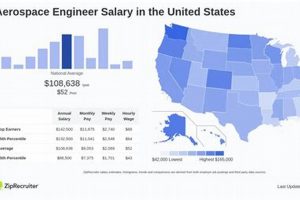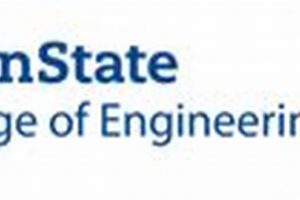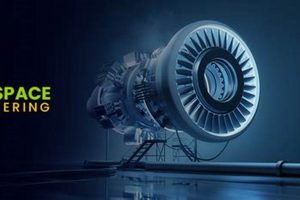The query at hand concerns the potential for individuals trained in the design, development, and testing of aircraft and spacecraft to transition into the field of physics that studies celestial objects, space, and the physical universe as a whole. Such a shift represents a move from applied engineering principles to theoretical and observational scientific inquiry.
This career change is viable due to overlapping skill sets. Both disciplines require strong mathematical and computational abilities, a solid understanding of physics, and problem-solving expertise. Historically, numerous individuals have successfully transitioned between engineering and scientific fields, leveraging their practical experience to contribute to fundamental research. The benefits of such a transition include bringing an engineer’s perspective to astrophysical challenges, fostering innovative approaches to instrument design, and enhancing the development of space-based observatories.
The following sections will explore the necessary educational adjustments, relevant skill transferability, and career pathways that facilitate a successful move into astrophysics for those with an aerospace engineering background.
Advancing from Aerospace Engineering to Astrophysics
Achieving a successful transition from aerospace engineering to astrophysics requires strategic planning and focused effort. The following tips offer guidance for engineers contemplating this shift.
Tip 1: Strengthen Foundational Physics Knowledge: Astrophysics demands a deep understanding of physics principles beyond those typically covered in an engineering curriculum. Focus on areas such as quantum mechanics, statistical mechanics, and electromagnetism.
Tip 2: Pursue Advanced Education: A master’s degree or doctorate in astrophysics or a closely related field is often essential. This provides specialized knowledge and research experience.
Tip 3: Develop Observational Skills: Gain hands-on experience with astronomical observations. This could involve volunteering at an observatory, participating in amateur astronomy groups, or enrolling in observational astronomy courses.
Tip 4: Enhance Computational Skills: Astrophysics relies heavily on computational modeling and data analysis. Proficiency in programming languages such as Python and statistical software packages is crucial.
Tip 5: Build a Research Portfolio: Actively engage in research projects, even if initially on a small scale. This demonstrates a commitment to scientific inquiry and builds credibility.
Tip 6: Network with Astrophysicists: Attend conferences, join professional organizations, and connect with researchers in the field. This facilitates mentorship and potential research opportunities.
Tip 7: Tailor Engineering Expertise: Identify how specific engineering skills, such as systems engineering or instrumentation design, can be applied to astrophysical research. This leverages existing strengths.
By strategically addressing these areas, aerospace engineers can build a strong foundation for a successful transition into the field of astrophysics. This transition requires dedication, but it opens opportunities to contribute to our understanding of the universe.
The subsequent sections will delve into the career paths available to those who successfully make this transition, highlighting the exciting possibilities that await.
1. Physics fundamentals
The transition from aerospace engineering to astrophysics requires a robust understanding of physics fundamentals. While aerospace engineering curricula include physics, the depth and breadth often differ from what is necessary for astrophysical research. Astrophysics delves into areas such as quantum mechanics, statistical mechanics, general relativity, and particle physics, which may not be central to standard aerospace engineering coursework. The absence of a strong foundation in these areas can significantly hinder an engineer’s ability to comprehend complex astrophysical phenomena, interpret observational data, and contribute meaningfully to theoretical models. For example, understanding quantum mechanics is crucial for analyzing the spectra of stars, while general relativity is essential for studying black holes and the large-scale structure of the universe.
The mastery of physics fundamentals directly influences an aerospace engineer’s capacity to engage in astrophysical research. A solid grasp of electromagnetism is necessary for understanding the behavior of plasmas in space, a field relevant to both astrophysics and space propulsion. Similarly, a strong background in thermodynamics and statistical mechanics is crucial for studying the interiors of stars and the formation of galaxies. The ability to apply these fundamental principles to real-world astrophysical problems is a key determinant of success in this career transition. For instance, an engineer with a deep understanding of fluid dynamics and heat transfer could contribute to the development of more accurate models of stellar convection.
In conclusion, physics fundamentals are not merely a prerequisite but a cornerstone for aerospace engineers aspiring to become astrophysicists. Deficiencies in this area represent a significant challenge, potentially limiting their ability to perform research, analyze data, and contribute to the advancement of astrophysical knowledge. Prioritizing the acquisition of a comprehensive understanding of physics fundamentals is, therefore, crucial for a successful transition. The commitment to continued learning and mastery of these core principles is a determining factor in an aerospace engineer’s capacity to make impactful contributions to the field of astrophysics.
2. Advanced Education
The pursuit of advanced education constitutes a critical juncture in the trajectory of an aerospace engineer seeking to transition into astrophysics. It represents the structured acquisition of specialized knowledge and research skills necessary to contribute meaningfully to this scientific domain.
- Formal Degree Programs
Enrolling in a Master’s or Doctoral program in astrophysics, physics, or a closely related field provides focused training. Such programs offer comprehensive coursework in astrophysics, cosmology, and related mathematical and computational techniques. For example, an aerospace engineer might pursue a PhD in astrophysics, focusing their research on the formation and evolution of galaxies, thereby gaining expertise in areas far removed from traditional aerospace engineering applications.
- Specialized Coursework
Targeted coursework fills knowledge gaps inherent in an aerospace engineering background. Courses in quantum mechanics, statistical mechanics, and general relativity are essential for understanding astrophysical phenomena. Without this specialized knowledge, comprehending the underlying physics governing celestial objects and space is challenging. For instance, understanding quantum mechanics is essential for interpreting stellar spectra, while general relativity is necessary for studying black holes.
- Research Experience
Active participation in research projects provides practical experience in scientific inquiry. This involves formulating research questions, designing experiments or simulations, analyzing data, and disseminating findings through publications and presentations. Such experience is often gained through graduate programs. For example, an engineer might join a research group studying exoplanets, learning to analyze transit data to determine planetary properties, thus building a research portfolio.
- Development of Computational Skills
Advanced education fosters proficiency in computational modeling and data analysis techniques. Astrophysicists rely heavily on computer simulations to model complex systems and analyze vast datasets from astronomical observations. This necessitates expertise in programming languages such as Python, as well as statistical and data visualization software. Without these skills, the ability to contribute to modern astrophysical research is limited. For example, an aerospace engineer could adapt their CFD skills to model the behavior of accretion disks around black holes.
Ultimately, advanced education serves as the bridge connecting the engineering expertise of an aerospace engineer to the scientific rigor required in astrophysics. The formal training, specialized coursework, research experience, and computational skills gained are indispensable for a successful transition and impactful contributions to the field.
3. Computational Abilities
The transition from aerospace engineering to astrophysics is significantly facilitated by strong computational abilities. In modern astrophysical research, computational modeling and data analysis are indispensable tools. Aerospace engineers typically possess a foundation in numerical methods, programming, and simulation techniques, which are directly transferable to astrophysical problems. For instance, the computational fluid dynamics (CFD) skills used to model airflow around aircraft wings can be adapted to simulate the dynamics of accretion disks around black holes or the interstellar medium. These skills enable engineers to analyze large datasets from telescopes, develop numerical models of astrophysical phenomena, and perform statistical analyses. Without such proficiency, the ability to contribute meaningfully to contemporary astrophysical research is substantially diminished. The correlation between computational skills and success in astrophysics stems from the increasing reliance on simulations and data-driven discoveries in the field.
Specific examples highlight the practical application of these abilities. An aerospace engineer familiar with structural analysis software could apply their expertise to model the internal stresses and strains within stars. Similarly, expertise in control systems could be leveraged to develop algorithms for pointing and tracking telescopes with greater precision. Furthermore, proficiency in machine learning and artificial intelligence is becoming increasingly valuable for analyzing the vast amounts of data generated by modern astronomical surveys. The capacity to develop and implement custom algorithms for data reduction, image processing, and source detection is critical for extracting meaningful information from raw observational data. This allows engineers-turned-astrophysicists to tackle complex problems, such as mapping dark matter distributions or identifying faint signals from distant galaxies, which would be intractable with traditional analytical methods.
In conclusion, the computational abilities acquired during aerospace engineering training provide a distinct advantage for individuals seeking to transition into astrophysics. While further specialized training in astrophysics-specific techniques may be necessary, the underlying foundation in numerical methods, programming, and simulation provides a robust starting point. The increasing reliance on computational approaches in modern astrophysical research underscores the practical significance of these skills, making them a key determinant of success in this career transition. Overcoming the challenges inherent in the transition requires recognizing and leveraging these existing computational strengths.
4. Research experience
Research experience is a critical determinant in the viability of an aerospace engineer’s transition into astrophysics. The effect of lacking research experience is a significant impediment to a successful career shift. It is a fundamental component needed in an individual’s profile to compete for positions in astrophysics. Examples of individuals with engineering backgrounds successfully transitioning into astrophysical research often highlight their engagement in research projects, either during advanced education or through independent initiatives. Such involvement provides invaluable hands-on experience, developing crucial skills in scientific inquiry, data analysis, and interpretation, none of which are typically emphasized within standard engineering curricula.
The practical significance of research experience lies in its demonstration of an individual’s capacity to conduct independent scientific work. It allows the engineer to not only apply theoretical knowledge but also to contribute to the advancement of astrophysical understanding. For instance, an aerospace engineer with experience in developing algorithms for satellite data processing could leverage this expertise in astrophysical research by working on projects involving the analysis of data from space-based telescopes. Likewise, participation in theoretical astrophysics projects, even through simulations or modeling, demonstrates an understanding of scientific methodologies and validates the engineer’s ability to contribute to new knowledge creation.
In conclusion, research experience is not merely an addition to the resume, but an essential element for an aerospace engineer aiming to become an astrophysicist. It serves as the primary means by which engineers can demonstrate their competence in the scientific method and their capacity to contribute meaningfully to the field. Acquiring relevant research experience is one of the greatest challenges engineers face and overcoming this lack of experience is essential to successfully integrating their background into the field of astrophysics.
5. Career pathways
Exploration of viable career pathways is essential for aerospace engineers considering a transition to astrophysics. Such pathways determine the practical application of acquired skills and knowledge within the field.
- Academic Research Positions
Universities and research institutions offer positions for astrophysicists engaged in theoretical and observational studies. An aerospace engineer’s background can be particularly valuable in areas involving space-based instrumentation or data analysis techniques. For example, expertise in systems engineering gained from aerospace projects is directly applicable to the development of new astronomical observatories and can apply their background to astrophysics research, which leads to better outcomes.
- Government Research Laboratories
Government agencies, such as NASA or national observatories, employ astrophysicists to conduct research and develop space missions. Engineers with experience in spacecraft design and mission planning find opportunities to contribute to projects related to astrophysics and cosmology. For instance, NASA’s astrophysics division leverages engineers’ expertise to design and implement space-based missions aimed at understanding dark energy and dark matter.
- Industry Roles in Space Technology
Companies involved in space technology and defense often require expertise in astrophysics for developing advanced sensors, communication systems, and data processing techniques. An aerospace engineer with training in astrophysics can contribute to the design and testing of technologies used in astronomical observation and space exploration. For example, engineers can utilize their knowledge of atmospheric physics and radiative transfer to improve the performance of remote sensing instruments used for Earth observation and planetary science.
- Science Communication and Education
Opportunities exist in science communication, education, and outreach roles at museums, planetariums, and educational institutions. An aerospace engineer turned astrophysicist can leverage their communication skills and passion for science to engage the public and inspire the next generation of scientists. For instance, individuals with backgrounds in both engineering and astrophysics can develop interactive exhibits that illustrate complex concepts in astrophysics, making them accessible to a wider audience.
Ultimately, these career pathways demonstrate the diverse possibilities available to aerospace engineers who successfully transition into astrophysics. Each path leverages distinct aspects of their engineering background, combined with specialized knowledge of astrophysics, to contribute to scientific advancement and technological innovation.
Frequently Asked Questions
This section addresses common inquiries regarding the transition from aerospace engineering to astrophysics, providing concise and informative answers.
Question 1: Is a formal degree in astrophysics essential?
While not always strictly mandatory, a Master’s or Doctoral degree in astrophysics or a closely related field is highly recommended. This provides the necessary specialized knowledge and research experience.
Question 2: What physics topics require additional study?
Quantum mechanics, statistical mechanics, general relativity, and advanced electromagnetism are areas where further study is often needed to supplement an aerospace engineering background.
Question 3: How crucial are computational skills?
Computational skills are of significant importance. Proficiency in programming languages, numerical modeling, and data analysis is vital for modern astrophysical research.
Question 4: Can engineering skills be directly applied to astrophysics?
Yes, engineering skills in areas such as systems engineering, instrumentation design, and data processing can be valuable in developing new astronomical observatories and analyzing astrophysical data.
Question 5: What career options are available with an astrophysics background?
Career paths include academic research, government research laboratories, industry roles in space technology, and science communication/education.
Question 6: Is previous research experience necessary for the transition?
Research experience is highly beneficial. It demonstrates competence in scientific inquiry and the ability to contribute to the field’s knowledge base.
The transition from aerospace engineering to astrophysics requires dedication, advanced education, and a willingness to acquire new skills. However, it represents a viable and rewarding career path.
The following sections will cover related issues or expand on specific topics discussed above.
Can an Aerospace Engineer Become an Astrophysicist?
This exploration has demonstrated that a career transition from aerospace engineering to astrophysics is indeed possible, although it necessitates significant effort and strategic preparation. The viability of such a shift hinges on acquiring specialized knowledge in physics, pursuing advanced education, cultivating strong computational skills, and gaining relevant research experience. The foundational skills inherent in an aerospace engineering background, particularly in areas such as systems engineering and data analysis, can provide a solid base for building a successful career in astrophysical research.
The potential for individuals with interdisciplinary backgrounds to contribute meaningfully to astrophysics is substantial. As technology advances and astrophysical research becomes increasingly reliant on sophisticated instrumentation and data analysis techniques, the value of engineers trained in astrophysics will only increase. Those considering this transition must be prepared for a challenging but ultimately rewarding path toward contributing to our understanding of the universe.







